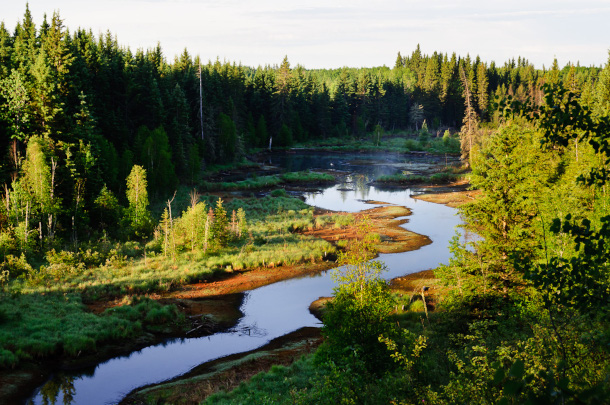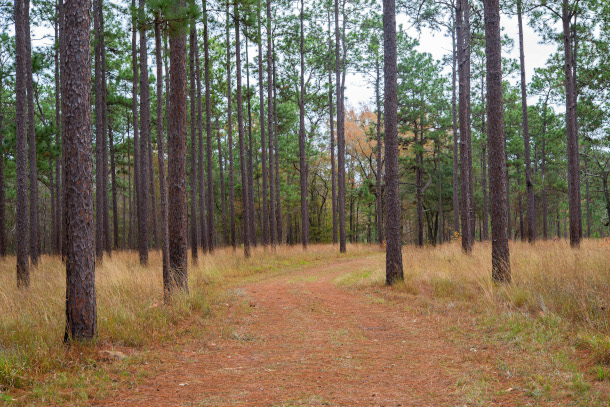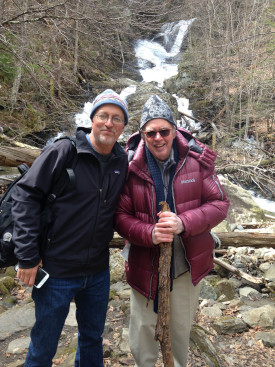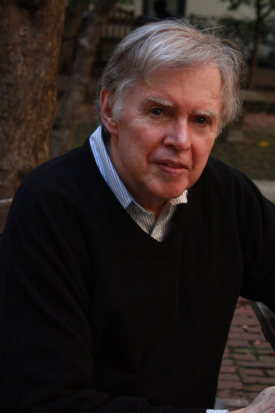Rescuing the Planet
Air Date: Week of May 21, 2021

The Boreal Forest is the world’s largest intact forest ecosystem and is a carbon sink. It’s estimated that if global warming exceeds the 3-5 degree Celsius heat stress and water scarcity could trigger extensive forest death and a dangerous release of the stored carbon dioxide into the atmosphere. (Photo: Kevin Owen, Flickr, CC BY NC ND 2.0)
Climate change is placing stress on plants and animals to rapidly adapt but without intact habitat, that could become impossible for many. Tony Hiss is an award-winning author and joins Host Bobby Bascomb to talk about his book Rescuing the Planet: Protecting Half the Land to Heal the Earth, which looks at several places across North America where communities are already working to protect habitat and biodiversity.
Transcript
BASCOMB: It’s Living on Earth, I’m Bobby Bascomb.
During his first few days in office President Biden announced the goal of protecting 30 percent of US land and water by the year 2030 with a long term goal of 50 percent by 2050. It’s an ambitious goal but one that scientists say is necessary if we are to avoid a mass planetary extinction. According to a UN report, roughly 1 million plant and animal species are already threatened with extinction including 40 percent of amphibians and a third of all marine mammals. Climate change is placing stress on plants and animals to rapidly adapt but without intact habitat, that could become impossible for many. So, in addition to slowing the trend of climate change, our best bet for preserving biodiversity is to protect habitat. And that is the focus of a new book by Tony Hiss titled, Rescuing the Planet: Protecting Half the Land to Heal the Earth. In it Tony takes a close look at several places across North America where people are already working to protect habitat and biodiversity. And he joins me now, welcome to Living on Earth Tony!
HISS: Thank you, Bobby. It's quite a pleasure to be with you.
BASCOMB: One focus of your book is the Boreal Forest in Canada and Alaska. Can you first please describe the Boreal for somebody who's never been there and give us a sense of the scale of the place and its importance.
HISS: You know, it's hard for a city boy like me to wrap my mind around a place like the Boreal even though I've now been there. It is perhaps the largest and most intact wildness left on planet Earth. It's way up at the top of Canada stretches into Alaska, it's 3,700 miles long, it's 1,000 miles from top to bottom. Extraordinary landscape, less cut over than the Amazon less cut over than the Siberian rainforest. And you get the kind of astonishment that we think people like Marquette and Jolliet sailing down the canoes down the Mississippi in 1673, found, or the Lewis and Clark found as they went West for Jefferson in the early 19th century. It's there, it's intact.

Longleaf pines once covered 90 million acres from Virginia to east Texas but today only about 5 percent of historic range remains intact. Marion Clifton Davis was a modern conservationist who bought tens of thousands of acres in the Florida sandhills and turned them into a private reserve, a project aimed at restoring back the Longleaf pine forest. (Photo: Florida Fish and Wildlife, Flickr, CC BY ND 2.0)
BASCOMB: And you write in your book that, you know, the boreal forest is this massive, intact wilderness, which is so important for the biodiversity of the region of the world. But it's also sitting on a carbon bomb potentially, if things go wrong in terms of climate change. Can you tell us more about that?
HISS: Oh, absolutely. It's a place that seems to have two nicknames. One is North America's bird nursery because something like 3 billion songbirds and shorebirds fly up there every year to raise the next generation. But its second nickname is the Fort Knox of carbon, because there is so much carbon locked up in the trees in the soil in the peat under the soil that if it were all released into the air at once, it would be the equivalent of something like 37 years worth of fossil fuel emissions bursting into the atmosphere at the same moment.
BASCOMB: So it's obviously very important to protect for a lot of reasons. And I understand that the Canadian government is looking to indigenous people that have been living there for millennia to help with that, can you tell us more about how that's working?
HISS: These are landscapes that have been continuously inhabited by native populations for let's say, 10,000 years. No one knows these landscapes like they do. And suddenly their expertise is being called upon, because the Canadian government with their participation is now setting up these enormous reserves called indigenous protected areas. And they're actually asking these First Nations people to be the rangers of these parks, to be what they're calling the mukluks on the ground. So far, it's going very well and there are plans for enormous additions, sort of almost California's worth of additions over the next 10 years or more. The Canadians, meaning the white Canadians were not kind to their first American populations first. But they've been in continuous occupation in these lands so they're ready and willing to take on the role of becoming the new guardians and official protectors and rangers of these vast, vast, vast new reserves.
BASCOMB: Well, there are several sort of unsung heroes in your book. There's a man named M.C. Davis, who made his wealth through gambling and then turned to conservation. Thanks to him thousands of acres in the Florida sand hills have been preserved. Could you tell us a bit more about him and his efforts, please?

Image of Mark Anderson, the advocate for "resilient" landscape conservation and the Nature Conservancy’s Director of Science for the Eastern U.S. (left) and author Tony Hiss (right) on a visit to Sanderson Brook in the Berkshires in the wilds of western Massachusetts. (Photo by Andy Finton)
HISS: He was one of the most wonderful people I got to meet wandering around the continent for this book. M.C. as you said, was a self made multimillionaire from the Florida Panhandle and he always referred to himself as a dirt road panhandle kind of guy. And one day, he was stuck in a traffic jam in Florida on his way home, furious fuming looked around and saw a sign on a high school billboard that said, "black bear seminar" and he thought, well it can't be worse than this. So he peeled off the road went inside. He said there were a couple of old drunks, few Canadian tourists who'd gotten lost number hoping for some free donuts. And up on the stage, these two amazing women talking about Florida black bears, which is a subspecies of black bear and how they were threatened. He was hooked, he was fascinated. And the next day he sent them enough money for their work for the next two years. Which he said sort of scared them. Who is this guy? Where was he coming from? What did he want? Well, what he wanted he told him was a list of the 100 most important environmental books so he could get up to speed and he spent a year reading those books and then he said, now I know what I can do. The great habitat for these bears is what was once the signature ecosystem of the southeast, the longleaf pine forest, which had almost entirely disappeared because after the Civil War in order to raise money they started chopping down these magnificent forests. That's probably the reason why Scarlett O'Hara said I'll never go hungry again. And M.C. on the cheap bought up 51,000 acres of played out peanut farms and scrub forests and began replanting longleaf pine seeds half a million a year. By the time I met him, he was in year 13 of his project still looked a bit scruffy, I had to tell him and he said, that's okay we're in year 13 of a 300 year project.
BASCOMB: Wow.
HISS: M.C. unfortunately has since passed on, but he'd left enough money to endow that work for the next 300 years. So there it is the Nokuse Plantation, a wonderful place.
BASCOMB: That's amazing. I mean, gosh, if everybody could turn a traffic jam into something as positive as that imagine where we'd be?
HISS: Yeah well, we got enough traffic jams to get started on.
BASCOMB: [LAUGH] That’s the truth. Now, you say in your book that several people in the past have proposed this kind of ambitious conservation effort, you know, we could’ve had 50% of the earth by 1950 had it been taken more seriously. But to what extent do you think things feel different now? I mean, in one of his early executive orders, President Biden committed to 30 by 30, which is an incremental step to 50 by 50. Does that feel different? I mean, do you think we can actually work towards this goal now in a meaningful way?
HISS: Well, that's a great question Bobby, because this feels to me like an issue that's been catching up with us and it's suddenly accelerating. About 10 years ago, when I started working on this book, I had a chance to meet with Edward O. Wilson, the great Harvard conservationist and biologist who's been pushing biodiversity he's a great champion of biodiversity for years and years. In talking with him I actually came up with the phrase Half Earth which he then has been running with. And even then he was thinking, well, half Earth is a way of waking people up. It's what he was calling a BHAG a big, hairy, audacious goal. And he said, sometimes you have to just sound the trumpet, and see what happens. Well, as you just said, The Biden administration has now embraced protecting 30% of the US by the year 2030 and 56 other countries have signed on to this as a goal for themselves. There's going to be a meeting in Kunming, China in October, at which 196 nations are expected to embrace this 30 by 30 goal. So suddenly talking about 50 by 50 which 10 years ago, seemed outlandish, preposterous, nutty, seems almost commonplace.

Tony Hiss, an author, lecturer, and consultant on restoring America's cities and landscapes. He is the author of thirteen books, including Rescuing the Planet: Protecting Half the Land to Heal the Earth. (Photo by Michael Lionstar)
BASCOMB: So how does this goal of, you know half Earth and preserving wildlife and biodiversity fit in with the notion of preserving, you know, the biosphere more broadly?
HISS: Well, one of the most remarkable people that I ran across working on my book, a rather fierce eyed looking Russian biologist named Vladimir Yovanovitch Vernadsky. And he wrote a book in 1926, called Biosfera was the first really close look at the biosphere. And it's thanks to him that we sort of can now see that the biosphere has three essential properties. One is it's very ancient, 3.8 billion years old or older. It's immense when you look around the world, it's this layer of life circumscribes the world. But the third thing is its third dimension, its height, or rather, its lack of height. Almost all of life is contained within this small band, from the bottom of the ocean up to the top of Mount Everest, that's 12 and a half miles. If it was stretched out horizontally, it's a distance you could drive in 20 minutes, you could drive from one end of life to the other in 20 minutes. So this place that is home to all of us by its very nature, it's vulnerable, it's tissue thin. The few people who have managed to get beyond the earth in rockets and look back at it have all been struck by the fact that it's gorgeous, amazing and vulnerable. And this has been sometimes called the overview effect. I think now what we're being called on when what's emerging in us is, is seeing the same thing from down below more of an inner view effect. So it's within that context that all our decisions are made. And it's what's telling us to love what's here but also to be careful about any of the changes we make.
BASCOMB: Tony Hiss is the author of Rescuing the Planet: Protecting Half the Land to Heal the Earth. Tony, thank you so much for taking this time with me today.
HISS: Thank you so much.
Links
NRDC | “'Indigenous Communities Lead the Way to Boreal Forest Protection”
Living on Earth wants to hear from you!
Living on Earth
62 Calef Highway, Suite 212
Lee, NH 03861
Telephone: 617-287-4121
E-mail: comments@loe.org
Newsletter [Click here]
Donate to Living on Earth!
Living on Earth is an independent media program and relies entirely on contributions from listeners and institutions supporting public service. Please donate now to preserve an independent environmental voice.
NewsletterLiving on Earth offers a weekly delivery of the show's rundown to your mailbox. Sign up for our newsletter today!
 Sailors For The Sea: Be the change you want to sea.
Sailors For The Sea: Be the change you want to sea.
 The Grantham Foundation for the Protection of the Environment: Committed to protecting and improving the health of the global environment.
The Grantham Foundation for the Protection of the Environment: Committed to protecting and improving the health of the global environment.
 Contribute to Living on Earth and receive, as our gift to you, an archival print of one of Mark Seth Lender's extraordinary wildlife photographs. Follow the link to see Mark's current collection of photographs.
Contribute to Living on Earth and receive, as our gift to you, an archival print of one of Mark Seth Lender's extraordinary wildlife photographs. Follow the link to see Mark's current collection of photographs.
 Buy a signed copy of Mark Seth Lender's book Smeagull the Seagull & support Living on Earth
Buy a signed copy of Mark Seth Lender's book Smeagull the Seagull & support Living on Earth

